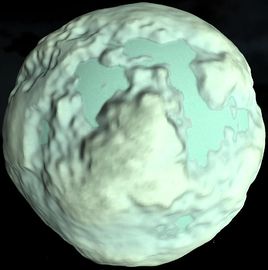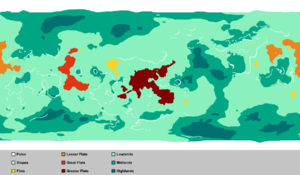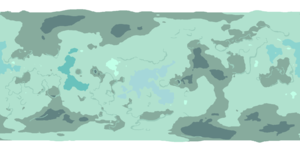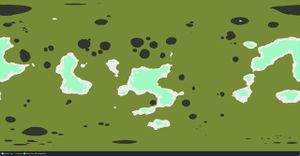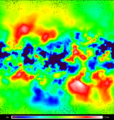Difference between revisions of "Minmus"
UmbralRaptor (talk | contribs) (Topography, description) |
|||
| (213 intermediate revisions by more than 100 users not shown) | |||
| Line 1: | Line 1: | ||
| − | + | {{Infobox/Body}} | |
| − | |||
| − | + | '''Minmus''' is the smallest [[moon]] of [[Kerbin]]. From the surface of [[Kerbin]] or the [[Mun]], it is a cyan speck one or two pixels wide which appears to slightly oscillate vertically. This is a result of viewing its rotation from afar. Up close, it is off-white in appearance with what seem to be icy buttes, large hills, and frozen lakes. The highest areas are over 5.7 km in altitude. It requires somewhat more delta-v to reach Minmus orbit than Mun orbit; however, given its very small gravity, it requires much less to land on the surface and return. This makes Minmus a primary source of Science in the early game after achieving an orbit of Kerbin. | |
| − | + | There is a [[tutorial]] about [[Tutorial:How to get to Minmus|traveling to Minmus]]. | |
| + | == In-game Description == | ||
| − | + | '''KSP 1:''' | |
| + | {{Quote | ||
| + | |Minmus is the smallest moon orbiting Kerbin. From the surface of Kerbin, it can be seen on clear days as a tiny blue speck in the sky. <br /> | ||
| + | <br /> | ||
| + | ''It is often mistaken as dirt on telescope lenses or dead pixels, but the top minds at the Kerbal Astronomical Society assure us it is a real moon nevertheless.'' | ||
| + | |[[Kerbal Astronomical Society]]}} | ||
| − | + | '''KSP 2:''' | |
| + | {{Quote | ||
| + | |Kerbin's second moon, Minmus, was long overlooked as most believed it was only a dead pixel or dust, much like Gilly. Despite the challenges of visiting it in its slightly inclined orbit, scientists were eager to study Minmus' fascinating geology, especially after seeing its impossible ice-like surface. Further analysis led researchers to conclude that the "ice" is actually glass, much to the dismay of Minmus's Mystic Crunch Milkshakes.|}} | ||
| − | + | == Orbital characteristics == | |
| + | Minmus orbits Kerbin at a continuous altitude of 46,400,000 meters and takes approximately 920 m/s Δv to transfer to from low Kerbin orbit. The [[w:Synodic period|synodic period]] from Kerbin's surface is 14 days, 3 hours and 1 second (1,220,401 seconds). A synchronous orbit around Minmus is possible at an altitude of {{OrbitAltitude|b=Minmus|f=k}}. The orbital speed around Minmus for an object with an altitude of 0 m is 171.5 m/s. | ||
| − | + | It is important to be careful when attempting to return to Kerbin from Minmus, as Minmus' high orbit makes it very easy to escape Kerbin's sphere of influence entirely. It may seem that Minmus would make a convenient refueling station for vessels leaving the Kerbin system. However, Kerbin's gravity is large enough that its Oberth effect gives considerable delta-V savings to craft leaving from low Kerbin orbit. Leaving Kerbin from Minmus orbit (which is very high) costs much more delta-V. | |
| − | + | An efficient way to return to a lower Kerbin orbit from Minmus is to use a gravity assist around [[Mun]]. Plan the maneuver carefully, though, as one gravity assist will send a vessel into a lower energy orbit around Kerbin, but another can send the vessel along an escape trajectory! | |
| − | + | == Surface Temperature == | |
| − | + | Minmus' surface temperature reaches 14°C in the day, and -107°C at night. | |
| − | + | Calculation of the expected surface temperature for Minmus, using received energy from [[Kerbol]], with the [[w:Stefan–Boltzmann law|Stefan-Boltzmann Law]] for the radiated power gives a temperature of -50 degrees Celsius. Whilst this is lower than the measured value, it lends support to the theory that Minmus is a captured comet. It could not have formed at its present location but has an albedo high enough to prevent catastrophic [[w:Sublimation (phase transition)|sublimation]] of its icy composition. A high salt content, if present, would also slow the sublimation process. | |
| − | + | This value of temperature was calculated using: An emissivity of 0.9 (close to but lower than compacted ice), an albedo of 0.6 (close to but lower than the real ice moon [[w:Europa|Europa]]), and the luminosity of 3 yottawatts for Kerbol. | |
| − | == | + | == Topography == |
| + | Minmus has very divergent elevations. Plateaus at around 5 km high are matched by "Flats" at datum altitude (0 m). Much of the surface is transitional lowlands and highlands. <!--[[Link is broken]] The vast majority of the surface is rolling hills, with lakes of a solid substance (such as ice or salt) concentrated near the equator.<ref>http://kerbalspaceprogram.com/forum/index.php?topic=13530.msg219016#msg219016</ref> --> With {{version|0.23}}, there are now 9 [[biome]]s. | ||
| − | + | The various "Flats" are almost perfectly flat (great for landing) and believed to have once been the site of liquid lakes. Minmus also has some mesas, one of which is near Minmus's north pole, that are so high compared to Minmus' [[sphere of influence]] that they count as "in orbit" according to the navigation tools. Unless the player manually switches the [[navball]] to Surface mode, this makes landing on these plateaus challenging, as the direction marker and speed will not automatically correct for the rotation of the surface. | |
| − | + | For most landings which are not on a plateau or in a lake, the touchdown altitude is usually between 2000 m and 2500 m. | |
| − | + | A [[kerbal]] jumping on this moon will make them ascend 12 m from the ground. | |
| − | + | Taking a [[Surface Sample]] from Minmus says that it is a "crystalline substance, definitely not edible". | |
| − | + | == Biomes == | |
| + | [[File:MinmusBiomeMap.png|thumb|none|Minmus biome map (legend)]] | ||
| + | Minmus has a total of 9 [[biome]]s. The most distinctive quality of Minmus's biomes is the variety of Flats, which in-game text describe as “lake beds”. They are almost perfectly flat and may represent [[w:Salt_pan_(geology)|salt flats]]. Roughly two-thirds of the surface area is irregular terrain transitioning between Highlands, Midlands, and Lowlands with Slopes in-between. | ||
| − | * | + | === Biome list === |
| + | {{Biome list| | ||
| + | * Poles | ||
| + | * Lowlands | ||
| + | * Midlands | ||
| + | * Highlands | ||
| + | * Slopes | ||
| + | * Flats | ||
| + | * Lesser Flats | ||
| + | * Great Flats | ||
| + | * Greater Flats}} | ||
| − | == | + | == KSP2 == |
| − | + | === Surface Research Locations === | |
| + | Surface research locations include: | ||
| + | |||
| + | * Arctic Ice | ||
| + | * Craters | ||
| + | * Sheet Ice | ||
| + | * Snowdrifts | ||
| + | |||
| + | ==== Monument ==== | ||
| + | {{SpoilerBox | ||
| + | |description=Spoiler | ||
| + | |content=the Monument is a discovery located at the center of a northern crater. It counts as a research location only on the surface, and it is located at 63°37'43" N 56°44'06" W. It consists of a 100m tall stone statue on a circular dais, surrounded by six equidistant pillars. Both the statue and the pillars are adorned with large crystals that emit a soft glow, providing a reference for landing even at night. | ||
| + | |||
| + | Finding the Minmus monument is one of the early primary missions of KSP2.}} | ||
| + | |||
| + | === Maps === | ||
| + | ==== Biomes ==== | ||
| + | [[File:minmus_region_ui.jpg|thumb|none|Minmus biome map with legend (as of v0.2.1.0 (from Orbital Survay mod))]] | ||
| + | |||
| + | ==== Visual map ==== | ||
| + | [[File:minmus_visual.png|thumb|none|Minus visual map (as of v0.2.1.0)]] | ||
| + | [https://i.imgur.com/U102vZt.png Minmus visual map (Imgur)] | ||
| + | |||
| + | == Science == | ||
| + | |||
| + | Although the [[science]]-multipliers of Minmus's surface and orbit are quite low compared to that of other planets and moons (but a little higher than [[Mun]]), Minmus is comparably easy to reach and to return from and has a very large number of biomes which all yield different science results. Unlike Mun, Minmus's biomes are easily discernable by eye, making it easier to run over all biomes without using ScanSat or other similar mods. A relatively small 1.25m lander using [[LV-909 Liquid Fuel Engine|LV-909s]] can reach Minmus, hop over all biomes and return to Kerbin on one run. This makes it – together with [[Mun]] – the main source of science points during the midgame. | ||
== Reference Frames == | == Reference Frames == | ||
| − | + | {{:Minmus/RefFrame}} | |
| − | + | ||
| − | + | ||
| − | + | == Gallery == | |
| − | | | + | <gallery> |
| − | | | + | File:SSTO Landing on minmus.png|A craft landing on Minmus. |
| − | | | + | File:Min_color.png|A full projection map of Minmus as of version 0.15 and above |
| − | | | + | File:Minmus Topo mercator 400x400.png|A topographic map of Minmus made with the ISA MapSat plugin |
| − | | | + | File:MunAndKerbinFromMinmus.png | Mun and Kerbin as seen from the surface of Minmus |
| − | | | + | File:MinmusLander.png|A lander escaping Minmus |
| − | | | + | File:Jebminmus.jpg | Jeb hopping along the surface of Minmus |
| − | | | + | File:Minmus-bobdab.png | Minmus, the small, cyan speck.. |
| − | | | + | File:Minmus_from_south_pole.jpg | Due to Minmus' inclined orbital plane, It can be seen from Kerbin's south pole for a time. |
| − | |- | + | File:Minmus Humvee.png | A 2 seater Humvee on Minmus. |
| − | | | + | File:Screenshot94.png | A Minmus landing party partying after landing. |
| − | | | + | File:Kerbal Space Program Enhanced Edition 20210620201609.jpg | A small old-styled lander flying over a Minmus flat. |
| − | | | + | |
| − | | | + | |
| − | | | + | </gallery> |
| − | |- | + | {{SpoilerBox |
| − | + | |description=Spoiler image | |
| − | + | |content=<gallery> | |
| − | + | Minmus Monolith.png | The only monolith on Minmus. | |
| − | + | ||
| − | + | </gallery>}} | |
| − | + | ||
| − | + | == Trivia == | |
| − | | 60, | + | * The name "Minmus" may be derived from the Latin word “[[wiktionary:minimus|minimus]]”, which denotes the smallest member of a group of beings or creatures, and is also the medical name for the smallest digit on the hand or foot. Minmus is the smallest member of the Kerbin system. |
| − | | | + | :* "Minimus" is a frequent misspelling of Minmus. |
| + | * It's also possible that Minmus is named after Saturn's moon [[w:Mimas (moon)|Mimas]]. | ||
| + | * It's been speculated that Minmus was inspired by Haruki Murakami's book [[w:1Q84|1Q84]], in which the protagonist discovers she is in an alternate-reality in part by noticing a tiny, moss-green moon in the sky next to the moon she knows.<ref>http://forum.kerbalspaceprogram.com/threads/96074</ref><ref>http://www.nytimes.com/2011/11/10/books/1q84-by-haruki-murakami-review.html</ref> | ||
| + | * It is possible to deorbit, land and ascend back into orbit around Minmus with the EVA jetpack starting at 100% fuel. | ||
| + | * If [[2HOT Thermometer]] is used on surface, it shows a temperature of -0.007, which is just enough for water to freeze. | ||
| + | * If [[SC-9001 Science Jr.]] is used near or on Minmus in career mode, it will state that its test samples start to glow due to radiation. This might cause Minmus to have a higher temperature than Mun. | ||
| + | * Various lines of text in the game mention that Kerbals think Minmus looks like mint ice cream. | ||
| + | * Minmus is large enough that, if it orbited the Sun, it would be considered a planet or a dwarf planet. If you make Minmus 10 times larger but with the same surface gravity (i.e. you make it Real Solar System sized) Minmus is both larger and denser than the Saturnian moon Mimas, which is the smallest object in the solar system known to be spherical due to hydrostatic equilibrium (its gravity makes it spherical). The criteria for an object being a planet is 1) it must orbit the sun, 2) it must have cleared its orbit, 3) it must be in hydrostatic equilibrium. Dwarf planets disregard the second criterion. If Minmus orbited the sun, it would satisfy at least two of those criteria. | ||
| + | * Minmus, Gilly, and Pol are the only bodies in the solar system that are completely procedurally generated. | ||
| + | * Solar System creator NovaSilisko had suggested that Minmus was an ancient comet that had become captured into Kerbin orbit. | ||
| + | *When a seismic scan is run by the Double-C Seismic Accelerometer on the surface, it says that due to vibrations, the planet may not be entirely solid, meaning that there is most likely a subsurface ocean under the crust of Minmus, | ||
| + | |||
| + | == Changes == | ||
| + | ;[[0.23]] | ||
| + | * Biomes added. | ||
| + | ;[[0.17]] | ||
| + | * Minmus is no longer tidally locked to Kerbin.<ref>http://www.reddit.com/r/KerbalSpaceProgram/comments/10q9z2/minmus_lost_its_tidal_lock_to_kerbin_in_v017/</ref> | ||
| + | * Minmus' mass reduced.<ref>http://kerbalspaceprogram.com/forum/showthread.php/24156-Is-Minmus-on-a-weight-loss-program</ref> | ||
| + | * Synchronous orbit is now possible. Previously, it would have required an altitude of {{OrbitAltitude | period=(299.25*60*60) | mass=4.233e19 | radius=60000 | factor=k }}, outside Minmus' sphere of influence. | ||
| + | ;[[0.15]] | ||
| + | * Initial release | ||
| + | |||
| + | === KSP 2 === | ||
| + | ;v0.2.0.0 | ||
| + | * Research locations added. | ||
| + | |||
| + | == See also == | ||
| + | * [[Tutorial:How to get to Minmus|Tutorial on travelling from Kerbin to Minmus]] | ||
| − | == | + | == Notes == |
| − | + | <references /> | |
| − | |||
| − | |||
| − | |||
| − | |||
| + | {{Celestial Bodies}} | ||
[[Category:Celestials]] | [[Category:Celestials]] | ||
| + | [[Category:Moons]] | ||
Latest revision as of 13:38, 26 October 2024
| Minmus | ||
| Minmus as seen from orbit. | ||
| Moon of Kerbin | ||
| Orbital Characteristics | ||
| Semi-major axis | 47 000 000 m [Note 1] | |
| Apoapsis | 47 000 000 m [Note 1] | |
| Periapsis | 47 000 000 m [Note 1] | |
| Orbital eccentricity | 0 | |
| Orbital inclination | 6 ° | |
| Argument of periapsis | 38 ° | |
| Longitude of the ascending node | 78 ° | |
| Mean anomaly | 0.9 rad (at 0s UT) | |
| Sidereal orbital period | 1 077 311 s | |
| 49 d 5 h 15 m 10.5 s | ||
| Synodic orbital period | 1 220 131.7 s | |
| Orbital velocity | 274 m/s | |
| Longest time eclipsed | 4 378 s | |
| Physical Characteristics | ||
| Equatorial radius | 60 000 m | |
| Equatorial circumference | 376 991 m | |
| Surface area | 4.5238934×1010 m2 | |
| Mass | 2.6457580×1019 kg | |
| Standard gravitational parameter | 1.7658000×109 m3/s2 | |
| Density | 29 242.046 kg/m3 | |
| Surface gravity | 0.491 m/s2 (0.05 g) | |
| Escape velocity | 242.61 m/s | |
| Sidereal rotation period | 40 400.000 s | |
| 1 d 5 h 13 m 20 s | ||
| Sidereal rotational velocity | 9.3315 m/s | |
| Synchronous orbit | 357.94 km | |
| Sphere of influence | 2 247 428.4 m [Note 1] | |
| Atmospheric Characteristics | ||
| Atmosphere present | No | |
| Scientific multiplier | ||
| Surface | 5 | |
| Splashed | N/A | |
| Near space | 4 | |
| Outer space | 2.5 | |
| Recovery | 2.5 | |
|
| ||
Minmus is the smallest moon of Kerbin. From the surface of Kerbin or the Mun, it is a cyan speck one or two pixels wide which appears to slightly oscillate vertically. This is a result of viewing its rotation from afar. Up close, it is off-white in appearance with what seem to be icy buttes, large hills, and frozen lakes. The highest areas are over 5.7 km in altitude. It requires somewhat more delta-v to reach Minmus orbit than Mun orbit; however, given its very small gravity, it requires much less to land on the surface and return. This makes Minmus a primary source of Science in the early game after achieving an orbit of Kerbin.
There is a tutorial about traveling to Minmus.
Contents
In-game Description
KSP 1:
| “ | Minmus is the smallest moon orbiting Kerbin. From the surface of Kerbin, it can be seen on clear days as a tiny blue speck in the sky.
|
” |
KSP 2:
| “ | Kerbin's second moon, Minmus, was long overlooked as most believed it was only a dead pixel or dust, much like Gilly. Despite the challenges of visiting it in its slightly inclined orbit, scientists were eager to study Minmus' fascinating geology, especially after seeing its impossible ice-like surface. Further analysis led researchers to conclude that the "ice" is actually glass, much to the dismay of Minmus's Mystic Crunch Milkshakes. | ” |
Orbital characteristics
Minmus orbits Kerbin at a continuous altitude of 46,400,000 meters and takes approximately 920 m/s Δv to transfer to from low Kerbin orbit. The synodic period from Kerbin's surface is 14 days, 3 hours and 1 second (1,220,401 seconds). A synchronous orbit around Minmus is possible at an altitude of 357.94 km. The orbital speed around Minmus for an object with an altitude of 0 m is 171.5 m/s.
It is important to be careful when attempting to return to Kerbin from Minmus, as Minmus' high orbit makes it very easy to escape Kerbin's sphere of influence entirely. It may seem that Minmus would make a convenient refueling station for vessels leaving the Kerbin system. However, Kerbin's gravity is large enough that its Oberth effect gives considerable delta-V savings to craft leaving from low Kerbin orbit. Leaving Kerbin from Minmus orbit (which is very high) costs much more delta-V.
An efficient way to return to a lower Kerbin orbit from Minmus is to use a gravity assist around Mun. Plan the maneuver carefully, though, as one gravity assist will send a vessel into a lower energy orbit around Kerbin, but another can send the vessel along an escape trajectory!
Surface Temperature
Minmus' surface temperature reaches 14°C in the day, and -107°C at night.
Calculation of the expected surface temperature for Minmus, using received energy from Kerbol, with the Stefan-Boltzmann Law for the radiated power gives a temperature of -50 degrees Celsius. Whilst this is lower than the measured value, it lends support to the theory that Minmus is a captured comet. It could not have formed at its present location but has an albedo high enough to prevent catastrophic sublimation of its icy composition. A high salt content, if present, would also slow the sublimation process.
This value of temperature was calculated using: An emissivity of 0.9 (close to but lower than compacted ice), an albedo of 0.6 (close to but lower than the real ice moon Europa), and the luminosity of 3 yottawatts for Kerbol.
Topography
Minmus has very divergent elevations. Plateaus at around 5 km high are matched by "Flats" at datum altitude (0 m). Much of the surface is transitional lowlands and highlands. With version 0.23, there are now 9 biomes.
The various "Flats" are almost perfectly flat (great for landing) and believed to have once been the site of liquid lakes. Minmus also has some mesas, one of which is near Minmus's north pole, that are so high compared to Minmus' sphere of influence that they count as "in orbit" according to the navigation tools. Unless the player manually switches the navball to Surface mode, this makes landing on these plateaus challenging, as the direction marker and speed will not automatically correct for the rotation of the surface.
For most landings which are not on a plateau or in a lake, the touchdown altitude is usually between 2000 m and 2500 m.
A kerbal jumping on this moon will make them ascend 12 m from the ground.
Taking a Surface Sample from Minmus says that it is a "crystalline substance, definitely not edible".
Biomes
Minmus has a total of 9 biomes. The most distinctive quality of Minmus's biomes is the variety of Flats, which in-game text describe as “lake beds”. They are almost perfectly flat and may represent salt flats. Roughly two-thirds of the surface area is irregular terrain transitioning between Highlands, Midlands, and Lowlands with Slopes in-between.
Biome list
|
KSP2
Surface Research Locations
Surface research locations include:
- Arctic Ice
- Craters
- Sheet Ice
- Snowdrifts
Monument
Maps
Biomes
Visual map
Science
Although the science-multipliers of Minmus's surface and orbit are quite low compared to that of other planets and moons (but a little higher than Mun), Minmus is comparably easy to reach and to return from and has a very large number of biomes which all yield different science results. Unlike Mun, Minmus's biomes are easily discernable by eye, making it easier to run over all biomes without using ScanSat or other similar mods. A relatively small 1.25m lander using LV-909s can reach Minmus, hop over all biomes and return to Kerbin on one run. This makes it – together with Mun – the main source of science points during the midgame.
Reference Frames
| Time warp | Minimum Altitude |
|---|---|
| 1× | Any |
| 5× | 3 000 m |
| 10× | 3 000 m |
| 50× | 6 000 m |
| 100× | 12 000 m |
| 1 000× | 24 000 m |
| 10 000× | 48 000 m |
| 100 000× | 60 000 m |
Gallery
Trivia
- The name "Minmus" may be derived from the Latin word “minimus”, which denotes the smallest member of a group of beings or creatures, and is also the medical name for the smallest digit on the hand or foot. Minmus is the smallest member of the Kerbin system.
- "Minimus" is a frequent misspelling of Minmus.
- It's also possible that Minmus is named after Saturn's moon Mimas.
- It's been speculated that Minmus was inspired by Haruki Murakami's book 1Q84, in which the protagonist discovers she is in an alternate-reality in part by noticing a tiny, moss-green moon in the sky next to the moon she knows.[1][2]
- It is possible to deorbit, land and ascend back into orbit around Minmus with the EVA jetpack starting at 100% fuel.
- If 2HOT Thermometer is used on surface, it shows a temperature of -0.007, which is just enough for water to freeze.
- If SC-9001 Science Jr. is used near or on Minmus in career mode, it will state that its test samples start to glow due to radiation. This might cause Minmus to have a higher temperature than Mun.
- Various lines of text in the game mention that Kerbals think Minmus looks like mint ice cream.
- Minmus is large enough that, if it orbited the Sun, it would be considered a planet or a dwarf planet. If you make Minmus 10 times larger but with the same surface gravity (i.e. you make it Real Solar System sized) Minmus is both larger and denser than the Saturnian moon Mimas, which is the smallest object in the solar system known to be spherical due to hydrostatic equilibrium (its gravity makes it spherical). The criteria for an object being a planet is 1) it must orbit the sun, 2) it must have cleared its orbit, 3) it must be in hydrostatic equilibrium. Dwarf planets disregard the second criterion. If Minmus orbited the sun, it would satisfy at least two of those criteria.
- Minmus, Gilly, and Pol are the only bodies in the solar system that are completely procedurally generated.
- Solar System creator NovaSilisko had suggested that Minmus was an ancient comet that had become captured into Kerbin orbit.
- When a seismic scan is run by the Double-C Seismic Accelerometer on the surface, it says that due to vibrations, the planet may not be entirely solid, meaning that there is most likely a subsurface ocean under the crust of Minmus,
Changes
- Biomes added.
- Minmus is no longer tidally locked to Kerbin.[3]
- Minmus' mass reduced.[4]
- Synchronous orbit is now possible. Previously, it would have required an altitude of 4 302.99 km, outside Minmus' sphere of influence.
- Initial release
KSP 2
- v0.2.0.0
- Research locations added.
See also
Notes
- ↑ http://forum.kerbalspaceprogram.com/threads/96074
- ↑ http://www.nytimes.com/2011/11/10/books/1q84-by-haruki-murakami-review.html
- ↑ http://www.reddit.com/r/KerbalSpaceProgram/comments/10q9z2/minmus_lost_its_tidal_lock_to_kerbin_in_v017/
- ↑ http://kerbalspaceprogram.com/forum/showthread.php/24156-Is-Minmus-on-a-weight-loss-program
